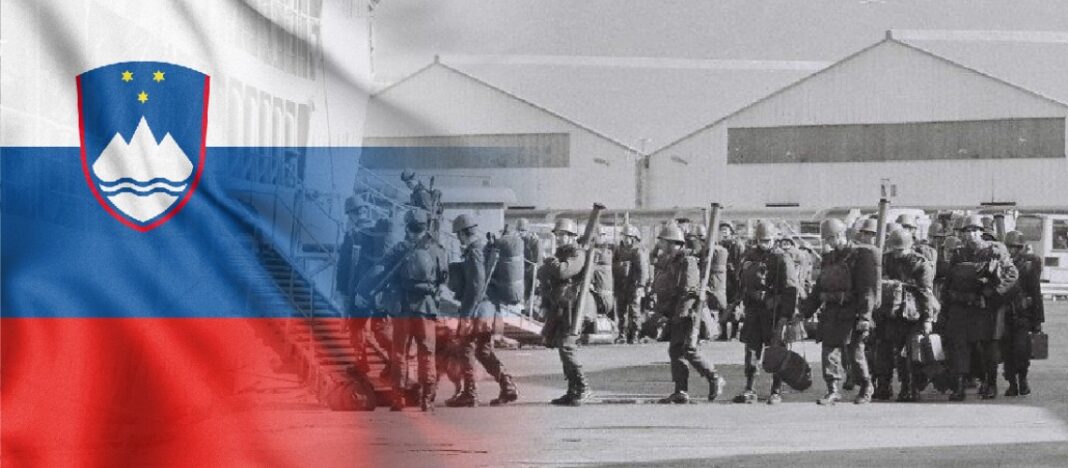By: C. R.. SDS
On the national holiday, Sovereignty Day, we remember one of the key actions in the process of Slovenian independence, because on this day in 1991, the last soldier of the aggressor Yugoslav People’s Army left Slovenian territory.
On this day 31 years ago, a turning point in the history of the Slovenian nation took place. On October 25th, 1991, the last soldier of the aggressor Yugoslav People’s Army left Slovenian territory, with which the Republic of Slovenia not only formally, but also actually became a sovereign state. We have not only become sovereign and free, but Slovenia has also become a safe country, which is a fundamental condition for stability, development, and economic prosperity. With the withdrawal of the foreign army, the conditions for the international recognition of the Republic of Slovenia were fulfilled. In memory of this extremely important and magnificent chapter in the history of the Slovenian nation, today we celebrate Sovereignty Day.
The armed conflict ended on July 4th, 1991, when YPA units began to retreat to their home barracks in Slovenia and neighbouring Croatia. Negotiations followed in Brijuni, where the representatives of both sides, together with the European delegation, adopted the Brijuni Declaration, which, among other things, provided for the withdrawal of YPA soldiers from Slovenia. On July 10th, 1991, the declaration was approved by the Slovenian Assembly and two days later by the Presidency of the SFRY, which still did not abandon the idea of Slovenia remaining part of Federative Yugoslavia. The greatest pressure was exerted by the YPA command, which demanded normal conditions for the operation and stay of its soldiers on Slovenian soil. The YPA had two choices to make, attack or retreat.
The decree adopted on July 18th, 1991, set a three-month deadline for the YPA army to withdraw from the Republic of Slovenia. A special commission was established and given the authority to negotiate with the YPA on the details of its withdrawal. The position of the Slovenian commission was that the withdrawal must cover all YPA ground forces on the territory of Slovenia and all forces of the Yugoslav Air Force and Air Defence, except for the work that was necessary for the unity of control over the airspace. The first withdrawals began at the end of July 1991, when parts of the tank brigade withdrew from the Vrhnika barracks.
The withdrawal of YPA units from Slovenia was made more difficult by the situation with its southern neighbour, where there were increasingly frequent clashes, as a result of which Croatia prohibited the movement of military convoys with weapons and equipment across its territory. After examining all possibilities, it was agreed that the units would withdraw via the port of Koper. October 18th, 1991, approached, and it became increasingly clear that the troops would not withdraw by the agreed deadline, so a new agreement followed, which provided for the last day for withdrawal to be October 25th, 1991. The first embarkation of YPA units in Luka Koper began on October 21st, when the school ship Galeb left the port. On the night of October 25th to 26th, 1991, the last calls were heard from the megaphone in the harbour for the soldiers to board the ship Venus as soon as possible and leave Slovenian territory. The ship Venus left the port of Koper a few minutes past midnight.
“In the Slovenian Democratic Party, we believe that we are not aware enough of the independence chapter of Slovenian history, and as a party born in the Slovenian spring, we respectfully preserve the memory of this period of the Slovenian past, which is very important to us, as well as the Slovenian nation. With a holiday like Sovereignty Day, the memory of one of the key events in the process of Slovenia’s independence is preserved, when the Yugoslav totalitarian government at the time wanted to suppress the efforts and centuries-old desire of the Slovenian people for their own country,” the SDS emphasised.
With the departure of the last YPA soldier, the symbol of the red star also departed. The departure of the symbol of the totalitarian state was proudly accompanied by Slovenian flags. They thought that the red star would never appear again in Slovenian territory. Today, the red star still exists as a symbol of the separation of the Slovenian nation and as a symbol of the utopian ideas of undemocratic regimes. Through the fight against the aggressor, the Slovenes showed a great degree of unity. Sovereignty Day can be characterised as a holiday of unity and unification of the Slovenian nation, and as such we must keep it in our memory and pass it on to our descendants.

